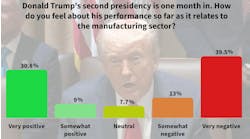China said Friday that output growth hit a three-year low in April, adding to pressure on Beijing to ease monetary policy after weak trade data the previous day fueled fears over the giant economy.
Official data showed on Friday that industrial output in the workshop of the world rose 9.3% last month, the slowest pace since May 2009 and below the 12.2% forecast in a poll of economists by Dow Jones Newswires.
Analysts said the data, combined with a fall in investment growth to 20.2% in the first four months of this year, boosted the case for allowing more credit to flow into the economy.
"China's economy is even weaker than thought, with industrial production growth back in single digits for the first time since the global financial crisis," said Ren Xianfang, an economist for IHS Global Insight.
China's economy grew 8.1% in the first quarter of 2012, its slowest pace in nearly three years, while leaders target growth of just 7.5% for the whole year -- down from 9.2% last year and 10.4% in 2010.
Beijing has already cut bank reserve requirements twice since December as it aims to boost lending to spur growth, but economists are calling for more policy changes as data continue to disappoint.
Inflation Eases
Also on Friday Beijing said the consumer price index (CPI), the main gauge of inflation, rose 3.4% year on year in April, compared with 3.6% in March.
The key food component rose 7.0% year on year -- contributing more than two percentage points to overall inflation -- although it is down from 7.5% in March, the National Bureau of Statistics said.
China has targeted annual inflation within 4% this year, in the knowledge that surging prices carry the potential to cause social unrest.
"The top issue for China's economy is not inflation, but rather how to maintain economic growth," Liao Qun, China economist for Citic Bank International in Hong Kong, told AFP.
Easing inflation should give China more room to pursue more active monetary policies to combat slower economic growth.
"The easing in inflation pressure opens the room for fine-tuning of monetary policy," said Zhu Haibin, an analyst with JP Morgan in Hong Kong, predicting up to three more reserve ratio cuts by the end of this year.
Investments in urban fixed assets rose 20.2% year on year in the first four months of 2012, weakening from 20.9% in January-March.
Fixed asset investment in the cities are a key gauge of government infrastructure spending, which has surged in recent years as Beijing has sought to cushion the impact of the global downturn.
"Today's data on April spending and output put another nail into hopes that China's economy is bottoming out," said Mark Williams, an analyst with Capital Economics.
Trade Data Disappoints
Friday's data added to the anemic trade figures on Thursday, which showed a rise of just 0.3% in imports for April while exports were up just 4.9%. That compared with analysts' forecasts of a 10% in imports 8.5% jump in overseas shipments.
The news highlighted the government's tough task of trying to shift to a more domestic-driven economy as it looks beyong exports, which have been hammered by Europe's debt crisis and stuttering recovery in the United States.
However, Friday's data also showed the producer price index (PPI), which measures the cost of goods at the farm and factory gate and indicates future consumer prices, slipped 0.7% in April from a year earlier, a sharper fall than the 0.3% in March.
Analysts said weakness in producer prices could become one of the main factors that spur the government to adopt further easing measures.
"The recovery is coming, but don't expect a problem-free growth spurt," IHS Global Insight said in a research note.
Chinese retail sales -- a guide on the government's progress in boosting domestic consumption -- rose 14.1% in April, down from 15.2% in March.
See also:
China's Trade Surplus Widens in April
Copyright 2012, Agence France-Presse



